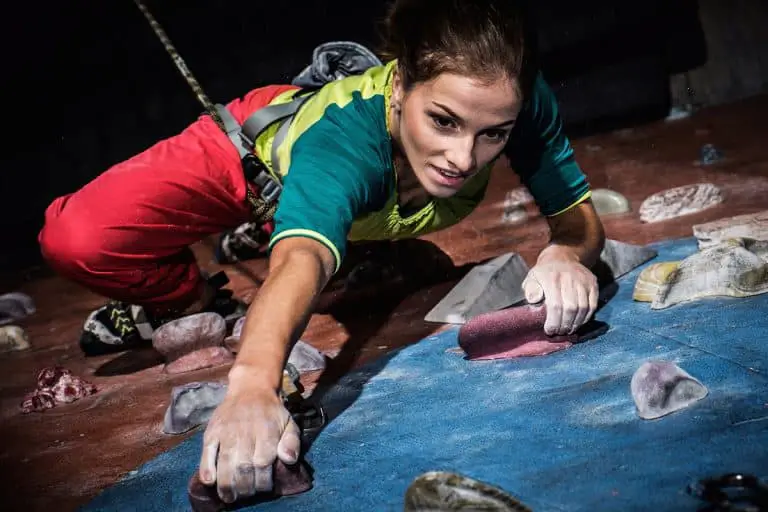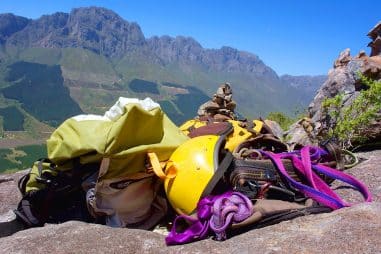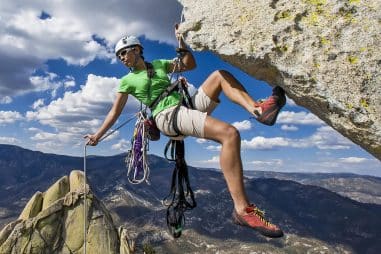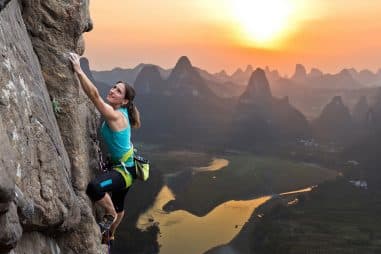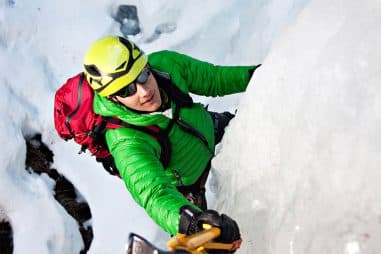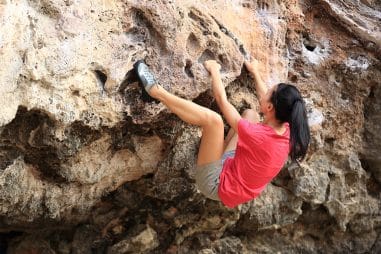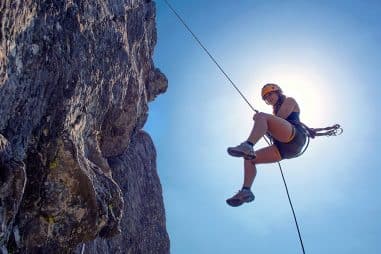Speed climbing competitions sanctioned by the International Federation of Sport Climbing (IFSC) use standardized artificial walls. The competition has a very simple rule. The competitors compete side-by-side on a wall with two climbing lanes and whoever reaches the top first wins.
How High Is a Speed Climbing Wall?
A speed climbing wall has a standardized height of 15 meters (49 feet). Comprised of two lanes, both 3 meters wide (10 feet), and an exact overhang of 5 degrees, these climbing walls are used for international competition. A shorter climbing wall measuring 10 meters is also used (33 feet) but unfortunately tracking speeds for this height is not international.
Apart from the height and width of the walls, the surface material (light grey, covered by a resin-quartz with 0.1/0.4 granulometry), the layout and model of holds (always made by the same manufacturer), timing system (includes a starting pad, a recording once the foot is lifted, and a stop device), and belay (top anchor, auto-belay system) also conform to the standard set by the International Federation of Sport Climbing (IFSC).
How Hard Is the Speed Climbing Route?
The speed climbing route is arbitrarily graded at F6b which translates roughly to 5.10c in rock climbing. Most recreational climbers can complete the 5.10c climb as this is considered intermediate in difficulty. For comparison, a 5.0 to 5.7 climb is easy, 5.8 to 5.10 is intermediate, 5.11 to 5.12 is hard and 5.13 to 5.15 is used only for the really difficult climbs.
However, there is no official grade for the speed climbing wall. The International Federation of Sport Climbing (IFSC) instead wants the focus to be on the speed of the ascent rather than the difficulty of the climb. There are no plans to change the design of the wall at the moment.
Is Speed Climbing Always the Same Route?
Speed climbing follows the same route with the handholds and footholds always in the same order and placement. This makes sure the competitors train on the same route and uses the same configurations when they train and compete. This also ensures that when records are set during competition, the walls climbed are identical and follows the standards set by the International Federation of Sport Climbing (IFSC).
The route was designed by a French climber named Jacky Godoffe who molded the holds and established the route being taken by today’s competitors. The pattern has not been changed in the 15 years since he created it. Although Godoffe has advocated changing the route every five years or so, there has not been any action on his suggestion.
Is Speed Climbing an Olympic Sport?
Speed climbing will be included in the 2020 Tokyo Olympic Games. This will be the first time that speed climbing will be included in the Olympic Games. The 2020 Olympics has been postponed to July-August 2021 due to the COVID-19 pandemic.
However, the speed climbing competition in the 2020 Olympics will not be a purely speed climbing competition. It will be a combination of three climbing disciplines; lead (climbing as high as possible in a given amount of time), bouldering (completing a number of fixed routes in a set time) and speed climbing will be combined into one climbing event. Competitors will be limited to 20 male and 20 female athletes in this edition of the Olympic Games.
Why Is Speed Climbing in the Olympics?
Speed climbing being included in the Olympics has the objective of generating new enthusiasm for the sport. This will allow the sport to be introduced to people who may not know much about it. This exposure aims to attract aspiring sportsmen and sportswomen to a new thrilling sport and allow equal opportunities for both genders to compete.
The inclusion of speed climbing sets a major landmark for the sport and indicates acceptance of climbing as a sport. It will be an incentive for serious rock climbers and the organizations growing the sport to further develop and promote it.
How Fast Can a Human Climb?
A skilled speed climber can climb up to 165 meters in one minute on a moderately difficult path. This is close to climbing about 2.75 meters (9 feet) per second! Admittedly, a person has to go through some serious training before achieving this level of proficiency.
The Holy Grail of speed climbing is to break the 5-second barrier for the 15-meter wall. This will be the goal of the upcoming crop of speed climbers.
Who Is the Fastest Climber in the World?
The fastest male speed climber in the world at the moment is an Iranian named Reza Alipourshenazandifar. The fastest female speed climber is Iuliia Kaplina of Russia. Both athletes hold the speed climbing world record at this time.
Another notable male speed climbers are Danyil Boldyrev of Ukraine who held the world record at 5.60 seconds before it was broken by Reza and Libor Hroza of the Czech Republic. They have individually held the male record for speed climbing before. Noteworthy female speed climbers are Aries Susanti Ruhayu of Indonesia and YILing Song of China, both of whom were world record holders at one time.
What Is the Speed Climbing Record?
The Iranian Reza Alipourshenazandifar holds the speed climbing record for men with a 5.48-second time set on April 2017 at the IFSC World Cup competition held in Nanjing, China. Iuliia Kaplina set the record of 6.964 seconds for female speed climbing during the IFSC European Championships in Moscow held in November 2020.
The difference between the world record and the second-best record in male speed climbing is 0.12 seconds. Iuliia Kaplina of Russia’s world record has a time of 6.964 seconds while Aries Susanti Ruhayu’s previous world record was at 6.995 seconds for a difference of only 0.031 seconds!
How Do You Train for Speed Climbing?
Training for speed climbing involves exercises for your core, forearms, leg work for explosive power, and finger strength for a stronger grip. At the start of the training, you should focus on getting the climbing motions memorized without the pressure of time. Start with simple routes to practice the basic motions and let muscle memory take over.
After mastering the basic route and motions, you can set up more elaborate routes. This creates the challenge of practicing with a different pattern and will help in learning to plan a route.
How Can I Climb Faster?
Racing up a wall is almost all legwork therefore you should do exercises that focus on strengthening the leg muscles. Plyometric (jumping) exercises will also develop the explosive leg power needed for the quick burst of energy needed to get up the wall. Running on inclines, stairs, and bleachers will also work the climbing muscles in your legs.
Finally, you should do as many laps in the wall as you think you need in a day of training. This will promote muscle memory, quicken reflexes, and improve body position while on the wall. The only way to improve your speed is to actually climb the wall.

